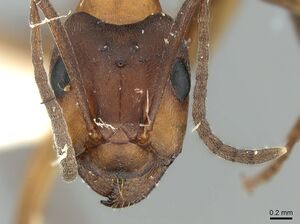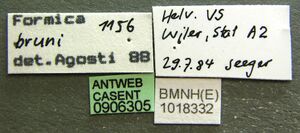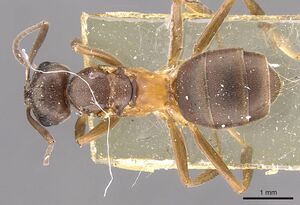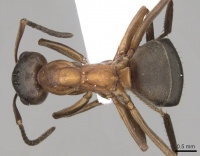Formica bruni
| Formica bruni | |
|---|---|

| |
| Scientific classification | |
| Kingdom: | Animalia |
| Phylum: | Arthropoda |
| Class: | Insecta |
| Order: | Hymenoptera |
| Family: | Formicidae |
| Subfamily: | Formicinae |
| Tribe: | Formicini |
| Genus: | Formica |
| Subgenus: | Coptoformica |
| Species: | F. bruni |
| Binomial name | |
| Formica bruni Kutter, 1967 | |
F. bruni is a specialised species of thermophilous, oligotrophic grasslands.
| At a Glance | • Temporary parasite |
Identification
Seifert (2000) - Formica bruni shows rather constant characters throughout its geographic range and is usually well-separable from the other species. However, specimens with reduced eye hairs could be confused in particular with Formica foreli and occasionally with Formica pressilabris. In such cases, both species can be separated from bruni by the absence of projecting frontolateral clypeal pubescense and the absence of second level clypeal setae. F. pressilabris additionally differs by the shorter SL/CL and very sparse frontal pubescence. Details of the most useful characters to differentiate bruni, foreli, and pressilabris are given in Table 7. Queens of bruni are separable from each W Palaearctic species on the individual level; the data in Tables 7 and 8 need no further comment. The best difference to the long-headed, continental manchu-fennica group is the more dense frontal and tergite pubescence and the sigificantly shorter head. The most reliable difference to large foreli queens with above-average EyeHL is the presence of lateral, projecting clypeal pubescence and of long and strong subdecumbent pubescence on promesonotum (MnHL > 40, in foreli always 0).
Males: Eyes usually with numerous hairs; EyeHL 6-35 μm. ClySet 1-2. Mesosoma with dense and long semierect pubescence and only occasionally with semierect setae. Craniad profile of forecoxae with zero to one standing setae. Pubescence in the ocellar triangle and on second gaster tergite very dense and short; sqrtPDF 2.8-3.9, sqrtPDG 3.9-5.0. Head not elongated; CL/CW 0.812 ± 0.025. Males with reduced setae on eyes and mesosoma are almost inseparable from Formica foreli.
Keys including this Species
- Key to Formica subgenus Coptoformica workers of Europe
- Key to Formica subgenus Coptoformica queens of Europe
Distribution
Formica bruni represents a submediterranean-suboceanic type with European origin. The frequent confusion with foreli and pressilabris led to an underestimation of its distribution. 112 samples identified by the author came from altogether 50 localities in Spain, France, Italy, Yugoslavia, Switzerland, Austria, Germany and S Sweden (two sites in Skåne). The French and Swiss Alps seem to be a distributional centre with 31 known sites. A record from the North Sea island of Terschelling/Netherlands (leg. Preuss) given by Agosti (1989) seems credible but needs confirmation. The vertical distribution in the W Alps ranges from 370 to 2150 m and is, as a consequence of grassland distribution, bimodal: 13 sites are situated at 708 ± 289 [370-1240] m and 18 sites at 1638 ± 231 [1380-2150] m.
Latitudinal Distribution Pattern
Latitudinal Range: 48.65° to 40.55°.
| North Temperate |
North Subtropical |
Tropical | South Subtropical |
South Temperate |
- Source: AntMaps
Distribution based on Regional Taxon Lists
Palaearctic Region: Austria, Germany, Greece, Iberian Peninsula, Italy, Romania, Spain, Sweden, Switzerland (type locality).
Distribution based on AntMaps
Distribution based on AntWeb specimens
Check data from AntWeb
Countries Occupied
| Number of countries occupied by this species based on AntWiki Regional Taxon Lists. In general, fewer countries occupied indicates a narrower range, while more countries indicates a more widespread species. |

|
Estimated Abundance
| Relative abundance based on number of AntMaps records per species (this species within the purple bar). Fewer records (to the left) indicates a less abundant/encountered species while more records (to the right) indicates more abundant/encountered species. |

|
Habitat
Seifert (2000) - F. bruni is a specialised species of thermophilous, oligotrophic grasslands. In the W Alps, the main habitats of the colline/submontane population are xerothermous grasslands (preferentially on limestone) and the montane/subalpine population is usually found on sunny, S-exposed pastures or hay meadows. The German, Austrian, and Swedish populations were found in xerothermous to semidry grasslands on limestone or sand.
Biology
Borowiec and Salata (2022) - Workers were collected on pastures in mountain plateau with limestone rocks. Nests in ground, entrance surrounded with a mound of finely cut grass and plant particles, the mound usually smaller than 40 cm in diameter. Mountain species, in Greece recorded from two localities at an altitude of 1485 m and 2200 m.
Seifert (2000):
Status as threatened species
In Germany one (threatened by extinction). In Switzerland probably two (severely threatened). The causes of decline are similar as in exsecta.
Colony foundation
The host species for socially parasitic foundation is an unknown Formica (Serviformica) species. Isolated, monogynous colonies are rare, i.e. the transition from monogyny to polygyny is apparently easier than in exsecta. As a rule, large polycalic colonies are found.
Nest construction
There is no difference to the normal Coptoformica type. The mounds do not reach the size known for exsecta and their diameter is normally < 50 cm. According to Feller (1985), nest entrances are always situated at the mound base. The subterranean part of an excavated summer nest showed a central vertical duct from which horizontal galleries branched off to chambers of 1-2 cm diameter that were distributed from near the surface down to 40 cm depth. Each chamber contained 2-3 queens.
Development and microclimatic requirements
In a polycalic colony near Martigny/Switzerland investigated by M. A. Schneider, oviposition usually begins in late March. Males and queens develop from the egg to the imago within 55-60 days (i.e., the first emerge from the pupae in late May). The developmental time of workers is 50 days in spring (first callows appear in mid-May) and 40 days in summer. The bulk of worker offspring ecloses from mid-July to mid-August.
Demography of nests and colonies
Two polycalic colonies in Switzerland comprised 250 nests/5644 m2 (near Martigny, M.A. Schneider) and 61 nests/4000 m2 (near Genolier, C. Feller). All nests were mutually friendly and exchanged populations. Two nests of 30-40 cm diameter were censused by Schneider for their winter population in late March. One nest contained 47500 workers and 79 queens and the other 51,279 workers and 326 queens. Nest splitting in spring leads to a higher number of less populous summer nests. The corrected estimate of Feller (1985) for an “average” summer nest of 20 cm diameter was a total of 3500 workers and 24 queens (site near Genolier). Population concentration in autumn is believed to reduce winter mortality and dispersing in spring improves economic recource utilization and territory defence. 25% of the nests in Martigny and 20% of those in Genolier produced alates. A bimodal but largely overlapping size distribution of the workers was observed by C. Feller; the larger workers preferentially performed Innendienst tasks and the smaller workers mainly Aussendienst tasks.
Swarming
In Central Europe, mature alates are found in the nests 19 July ± 12.0 d (15 June-13 Aug, n = 15). Observations on swarming and mating were made in Switzerland (Schneider pers. comm.): in polycalic colonies only about 5% of females fly, the others are inseminated at the nest mounds. Micraners fly higher and farther than macraners. Macraners stay near the nest and transmit more sperm per mating: 220,000 sperm cells against 120,000 in micraners. Sufficient air temperatures given, swarming takes place from 7.00 to 11.00 h a.m., as soon as the first direct sunlight hits the mound surface. Completely clouded sky prevents the flight and beginning sunshine in the second half of the day can not release it.
Food sources
F. bruni can use a wide range of food sources. Trophobiosis with Aphidina is most important. Coccidae are used less frequent and also Cicadina sucking at the roots and lowest sprout parts of herbs are tended; in the latter case the Cicadina colonies are protected by walls of plant material. Floral and extrafloral nectaries of diverse plant species in the field layer are intensively exploited. Zoophagous activity may be considerable: different developmental stages of insects, spiders, and earthworms are consumed. The foraging activity is mainly diurnal. Nocturnal activity is 25% of the diurnal activity in mid-summer; in spring and autumn it is lower (Schneider pers. comm.). Foraging completely stops at surface temperatures > 40 °C. Different polygynous societies that do not exchange workers or broods may share territories and even food sources.
Flight Period
| X | X | ||||||||||
| Jan | Feb | Mar | Apr | May | Jun | Jul | Aug | Sep | Oct | Nov | Dec |
Source: antkeeping.info.
- Check details at Worldwide Ant Nuptial Flights Data, AntNupTracker and AntKeeping.
 Explore: Show all Flight Month data or Search these data. See also a list of all data tables or learn how data is managed.
Explore: Show all Flight Month data or Search these data. See also a list of all data tables or learn how data is managed.
Life History Traits
- Mean colony size: 1,400 (Cherix & Maddalena-Feller, 1987; Beckers et al., 1989)
- Foraging behaviour: mass recruiter (Cherix & Maddalena-Feller, 1987; Beckers et al., 1989)
Castes
Worker
Images from AntWeb
   
| |
| Worker. Specimen code casent0906305. Photographer Estella Ortega, uploaded by California Academy of Sciences. | Owned by NHMUK, London, UK. |
Queen
Images from AntWeb
   
| |
| Syntype of Formica bruni. Queen (alate/dealate). Specimen code casent0907579. Photographer Z. Lieberman, uploaded by California Academy of Sciences. | Owned by MZL, Lausanne, Switzerland. |
Nomenclature
The following information is derived from Barry Bolton's Online Catalogue of the Ants of the World.
- bruni. Formica (Coptoformica) bruni Kutter, 1967a: 229, figs. 1-14 (w.q.m.) SWITZERLAND. See also: Kutter, 1977c: 284; Seifert, 2000a: 538.
Unless otherwise noted the text for the remainder of this section is reported from the publication that includes the original description.
Description
Worker
Borowiec and Salata (2022) - Large, HL: 1.238-2.325 (mean 1.288); HW: 0.976-1.071 (mean 1.029); SL: 1.159-1.270 (mean 1.217); EL: 0.349-0.384 (mean 0.361); ML: 1.64-1.79; MW: 0.70- 0.76. Color. Head bicolours, clypeus, genae, sides behind eyes and ventral side yellowish to yellowish red, rest of surface brown to black, pale anterior part of head gradually turn into the dark posterior part of head without sharp border between pale and dark parts; mesosoma usually uniformly yellowish to yellowish red, occasionally pronotum at top with obscure spot of diffused borders, petiolar scale usually yellowish to yellowish red, gaster brown to black with transparent white posterior margin of tergites, anterior slope of first tergite often yellowish brown, antennae yellowish red to red, sometimes apical antennomeres gradually infuscate, legs usually completely yellowish to yellowish brown. Head. Broad, 1.2-1.3 times longer than wide, in front of eyes softly converging anterad, behind eyes softly rounded, occipital margin deeply emarginate. Clypeus without or with obtuse median keel, on the whole surface distinctly microsculptured, slightly trapezoidal, its anterior margin convex, sides convergent posterad, posterior margin truncate, whole clypeal surface with very short and sparse appressed pubescence, clypeal margin with 3 long setae centrally and 4-5 short setae laterally, without setae in central and basal part of clypeal surface, the longest anterior seta with length 0.159. Head distinctly microreticulate, appears dull and opaque, with very short and very sparse appressed pubescence not covering head surface, erected setae absent. Scape moderately long, approximately 1.2 times as long as width of head, thin, distinctly reaching beyond the occipital margin, distinctly, regularly widened from base to apex, its surface microreticulate, with short and dense appressed pubescence, erected setae absent. Funicular segments elongate, thin, first segment 1.7 times as long as second segment, the second segment 1.7 times as long as wide, only slightly shorter than third segment, the rest of funicular segments clearly longer than broad. Eyes big, elongate oval, approximately 0.28 length of head. Mesosoma. Elongate in dorsal view distinctly constricted in the middle, 2.3-2.4 times as long as wide, dorsally and laterally distinctly microreticulated, surface indistinctly dull and opaque. In lateral view promesonotum convex, mesonotal groove deep, propodeum strongly, obtusely convex. Whole mesosomal surface covered with short and sparse appressed pubescence not covering the mesosomal surface, erected setae absent. Waist and gaster. Petiolar scale moderately broad, moderately thick in lateral view, apex straight but with very shallow median emargination, without setae. Gaster shorter than mesosoma, all tergites distinctly microreticulate, appears dull and opaque, covered with short and sparse appressed pubescence not covering surface of tergites. Tergites 1-2 completely without setae, also close to posterior margin a row of setae, tergite 3 without setae or close to posterior margin with 1-2 setae. Legs. Ventral surface of fore and mid femora with lacking erected setae.
Seifert (2000) - Medium-sized species (CL 1305 ± 72, 1090-1484; CW 1244 ± 77, 1033-1449). Head of average Coptoformica shape (CL/CW 1.050 ± 0.016, 0.999-1.096). Scape rather long (SL/CL 1.013 ± 0.025, 0.941-1.082). Setae only present on anterior clypeus, long decumbent pubescence hairs on frontolateral clypeus always present (ClySet 1.77 ± 0.49,1-3; ClyPub 3.79 ± 1.17, 1.0-6.5; Figs 3; 15). Lateral semierect setae in the ocellar triangle rarely present (OceSet 22%). Eye hairs more or less developed, maximum eye hair length at least in few specimens of a nest sample > 10 μm (EyeHL 15.4 ± 5.2, 4-29). Pubescence hairs in the occellar triangle short and very dense (Fig. 4, sqrtPDF 4.40 ± 0.41, 3.31-5.87). Craniad profile of forecoxae without or very few semierect setae (nCOXA 0.22 ± 0.55, 0-3). Dorsal mesosoma, lateral metapleuron and ventrolateral propodeum without standing setae (nMET 0.00 ± 0.04, 0-0.5). Outer edge of the hind tibial flexor side on the distal half with few subdecumbent setae (Fig. 2, nHTFL 4.11 ± 1.33, 1.0-8.0). Semierect setae on gaster tergites usually beginning at posterior border of third or fourth tergite (TERG 3.23 ± 0.70, 2-5). Pubescence density on first gaster tergite variable but usually rather low (sqrtPDG 6.36 ± 0.51, 5.10-7.75).
Queen
Seifert (2000) - Medium-sized (CL 1429 ± 37, 1354-1488; CW 1430 ± 44, 1340-1518; ML 2359 ± 91, 2232-2535). Head slightly elongated, but shorterheaded specimens occur (CL/CW 1.000 ± 0.025, 0.935-1.030), scape long (SL/CL 0.949 ± 0.016, 0.926-0.982). Setae restricted to anterior clypeus. Clypeus lateral of the tentorial pit level with pubescence hairs surpassing the anterior margin by more than 10 μm. Lateral semierect setae in the ocellar triangle usually absent but differentiation from pubescence difficult. Eye hairs relatively long (EyeHL 23.9 ± 4.8, 16-34). Pubescence in the occellar triangle short and extremely dense (sqrtPDF 3.46 ± 0.29, 3.05-3.98). Occipital corners of head with subdecumbent to decumbent pubescence (OccHD 23.6 ± 5.4, 12-30). Dorsal head surface relatively matt or weakly shining (GLANZ 1.33 ± 0.28, 1.0-2.0). Craniad profile of forecoxae without or very few decumbent setae but differentiation from pubescence difficult (nCOXA 1.00 ± 1.02, 0-3). Dorsum of head, mesosoma, and gaster with profuse and dense subdecumbent to decumbent pubescence. Dorsal mesosoma usually without clearly-defined strong setae but always with dense and long subdecumbent pubescence hairs single hairs of which approach in strength to setae (MnHL 73.2 ± 10.6, 48-91). Outer edge of the hind tibial flexor side on the distal half with few subdecumbent setae and with short decumbent pubescence (nHTFL 3.41 ± 1.37, 2.0-7.0). Semierect setae on gaster tergites usually beginning on the second to fourth tergite (TERG 2.88 ± 1.05, 1-4). Pubescence on first gaster tergite very dense (sqrtPDG 4.54 ± 0.47, 3.76-5.28).
Type Material
Seifert (2000) - Zermatt, Switzerland. Syntypes 1 male, 4 queens, 3 workers (Musée de Zoologie, Lausanne) [investigated].
References
- Beckers R., Goss, S., Deneubourg, J.L., Pasteels, J.M. 1989. Colony size, communication and ant foraging Strategy. Psyche 96: 239-256 (doi:10.1155/1989/94279).
- Borowiec, L. 2014. Catalogue of ants of Europe, the Mediterranean Basin and adjacent regions (Hymenoptera: Formicidae). Genus (Wroclaw) 25(1-2): 1-340.
- Borowiec, L., Salata, S. 2022. A monographic review of ants of Greece (Hymenoptera: Formicidae). Vol. 1. Introduction and review of all subfamilies except the subfamily Myrmicinae. Part 1: text. Natural History Monographs of the Upper Silesian Museum 1: 1-297.
- Bulter, I. 2020. Hybridization in ants. Ph.D. thesis, Rockefeller University.
- Kutter, H. 1967a [1966]. Einige Ergebnisse weiterer Coptoformica-Studien. Insectes Soc. 13: 227-240 (page 229, figs. 1-14 worker, queen, male described)
- Kutter, H. 1977c. Hymenoptera, Formicidae. Insecta Helv. Fauna 6: 1-298 (page 284, see also)
- Schifani, E. (2022). The new checklist of the Italian fauna: Formicidae. Biogeographia – The Journal of Integrative Biogeography 37, ucl006 (doi:10.21426/b637155803).
- Seifert, B 2000a. A taxonomic revision of the ant subgenus Coptoformica Mueller, 1923 (Hymenoptera: Formicidae). Zoosystema 22:517-568. (Hymenoptera: Formicidae). Zoosystema. 22:517-568.
- Seifert, B., Schultz, R. 2021. A taxonomic revision of the Palaearctic ant subgenus Coptoformica Müller, 1923 (Hymenoptera, Formicidae). Beiträge zur Entomologie 71 (2): 177–220 (doi:10.21248/contrib.entomol.71.2.177-220).
References based on Global Ant Biodiversity Informatics
- AntArea. Accessed on February 5th 2014 at http://antarea.fr/fourmi/
- Antarea (Personal Communication - Rumsais Blatrix- 27 April 2018)
- Antarea (at www.antarea.fr on June 11th 2017)
- Borowiec L. 2014. Catalogue of ants of Europe, the Mediterranean Basin and adjacent regions (Hymenoptera: Formicidae). Genus (Wroclaw) 25(1-2): 1-340.
- Borowiec L., and S. Salata. 2012. Ants of Greece - Checklist, comments and new faunistic data (Hymenoptera: Formicidae). Genus 23(4): 461-563.
- Casevitz-Weulersse J., and C. Galkowski. 2009. Liste actualisee des Fourmis de France (Hymenoptera, Formicidae). Bull. Soc. Entomol. Fr. 114: 475-510.
- Cherix D., and S. Higashi. 1979. Distribution verticale des fourmis dans le Jura vaudois et recensement prelimaire des bourdons (Hymenoptera, Formicidae et Apidae). Bull. Soc. Vaud. Sc. Nat. 356(74): 315-324.
- Czechowski W., A. Radchenko, W. Czechowska and K. Vepsäläinen. 2012. The ants of Poland with reference to the myrmecofauna of Europe. Fauna Poloniae 4. Warsaw: Natura Optima Dux Foundation, 1-496 pp
- Galkowski C. 2008. Quelques fourmis nouvelles ou intéressantes pour la faune de France (Hymenoptera, Formicidae). Bulletin de la Société Linnéenne de Bordeaux, 143, N.S. 36, 4 : 423-433.
- Glaser F. 1999. Erste Ergebnisse zur Verbreitung, Habitatbindung und Gefährdung der Untergattung Coptoformica (Hymenoptera: Formicidae) in Österreich. Myrmecologische Nachrichten 3: 55-62
- González Martín J. D., and X. Espadaler. 2011. Formicidos del País Vasco (Hymenoptera: Formicidae): Nuevas aportaciones. Heteropterus Revista de Entomologia 11(1): 109-122.
- Karaman M. G. 2011. A catalogue of the ants (Hymenoptera, Formicidae) of Montenegro. Podgorica: Catalogues 3, Volume 2, Montenegrin Academy of Sciences and Arts, 140 pp.
- Petrov I. Z., and C. A. Collingwood. 1992. Survey of the myrmecofauna (Formicidae, Hymenoptera) of Yugoslavia. Archives of Biological Sciences (Belgrade) 44: 79-91.
- Schultz R., and B. Seifert. 2007. The distribution of the subgenus Coptoformica Müller, 1923 (Hymenoptera: Formicidae) in the Palaearctic Region. Myrmecological News 10: 11-18.
- Seifert B. 1998. Rote Liste der Ameisen. - in: M. Binot, R. Bless, P. Boye, H. Gruttke und P. Pretscher: Rote Liste gefährdeter Tiere Deutschlands. Bonn-Bad Godesberg 1998: 130-133.
- Seifert B. 2000. A taxonomic revision of the ant subgenus Coptoformica Mueller, 1923 (Hymenoptera, Formicidae). Zoosystema 22: 517-568.
- Seifert B. 2007. Die Ameisen Mittel- und Nordeuropas. Tauer: lutra Verlags- und Vertriebsgesellschaft, 368 pp.
- Steiner F. M., S. Schödl, and B. C. Schlick-Steiner. 2002. Liste der Ameisen Österreichs (Hymenoptera: Formicidae), Stand Oktober 2002. Beiträge zur Entomofaunistik 3: 17-25.
- Wegnez P., D. Ignace, E. Lommelen, M. Hardy, J. Bogaert, and C. Nilsson. 2015. Redécouverte de Teleutomyrmex schneideriKutter, 1950 dans les Alpes françaises (Hymenoptera: Formicidae). Bulletin de la Société royale belge d’Entomologie 151: 52-57.
- Österreichische Gesellschaft für Ameisenkunde. 1995. Bemerkenswerte Ameisenfunde aus Österreich und angrenzender Gebiete (Hymenoptera: Formicidae). Myrmecologische Nachrichten 1: 1-3.





